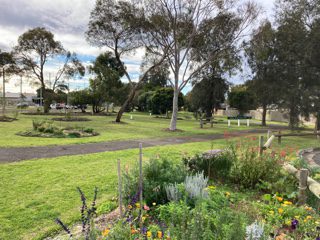
In 2019, the Hilltop Garden (0.5 acre) was designed and created by 2 women (community members) living in Herne Hill, an inner suburb of Geelong, Victoria. The original aim was to beautify the neighbourhood.
The land is part of a reserve with mature trees (no understory or topsoil), that is owned by VicTrack and leased to the City of Greater Geelong (local government). The reserve and Gabrielle Blythe trail path stretches north from this site to Church Street, Hamlyn Heights. The trail path now becomes named after Tom McKean, and continues through the suburb of Bell Park to North Geelong. It follows an old rail track starting from the Geelong Cement Works, on the opposite side of McCurdy Road, Herne Hill. Which overlooks the confluence of the Barwon River and Moorabool River. An important area of cultural significance for the Wadawurrung people. (Note: the silos were demolished March-June 2020).
The site is exposed to SW and NW wind (5-50km/hr). Sometimes doing a storm, the garden can experience winds of 100km/hr. There is no public access to water or rubbish collection.
After planning and consulting local community members and other people for their advice about the garden (February-July 2019), 3 crepe myrtle trees were planted, and 2 garden beds were made (July 2019). Some plants soon followed: herbs, flowers, bulbs, perennials. A 3rd garden bed was created after 3 oleander bushes were removed and replaced with 4 coastal banksia trees (2020). Pea straw mulch and home-made compost are used around plants and to cover the soil in these garden beds. The City of Greater Geelong provided deliveries of leaf-bark mulch. This has been placed around mature trees (eg. eucalyptus, she-oaks, paperbark) to help develop some topsoil, retain moisture, and provide additional space for more plants.
This means choosing plants suitable for the site: a mix of native and indigenous trees, shrubs and grasses on the westerly windy side, which are fast growing, with flowers (to attract pollinators), and will eventually provide a wind break. Other plants that can be more protected from the wind are on the easterly side (near the trail path and residents’ houses) such as: perennials, herbs, vegetables, bulbs, irises, deciduous trees, annual and biennial flowers. Using permaculture design principles, we are regularly assessing and maintaining the garden, putting in new plants mostly during the autumn-winter rainfall. In this way by revegetating the site, we are practising conservation and biodiversity. In time, the new trees and plants will provide more wind protection, shade and cooling, as well as contribute carbon sequestration in the soil.
Unexpectedly and to our delight, we have found the garden is slowly developing its own ecology by improving soil health and moisture, and attracting bees, birds and other pollinators. We are often visited by resident magpies in the morning, and have seen ladybirds, stick insects, bees, butterflies, dragonflies and other birds arriving in the garden. This gives us much peace and joy.
In addition, before, during and after the restrictions of the COVID-19 pandemic (2020-21), the garden, reserve and trail path became a source of wellbeing for community members and visitors alike. The garden is a new ‘third space’ in community; somewhere to enjoy being in nature and relax. A destination for social connectedness, conversation and physical activity (walking, cycling). Also offering children and their parents an opportunity for entertainment and homeschooling (eg. how plants grow, the beauty of flowers, seeing birds and insects).
We hope you will come along and visit the neighbourhood garden.
